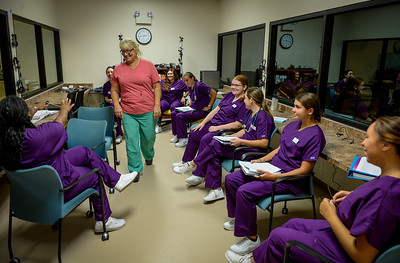Legislators in Lansing introduced a bill last week that would allow community colleges in the state to offer four-year nursing programs. The state has experienced a chronic shortage of nurses, and advocates say that community college nursing programs are the key to creating more nurses.
That solution assumes a vast number of students who cannot gain admission into nursing programs for lack of space. Or that students cannot afford four-year nursing programs and community college nursing programs are the natural solution.
The nursing shortage is attributable to a lot of factors, but lack of space in and costs of nursing programs aren’t chief among them. The population is aging, and an aging population requires more health care. Simply put, the demand for nursing services is rising. At the same time, the nurses in the workforce are also aging. More than a third of currently employed nurses are over the age of 50. No amount of legislation is going to change that.
The one factor that the legislation hopes to address with community college nursing programs is the number of programs available. Unfortunately, there are several other factors that contribute to the shortage of nurses.
Community college nursing programs may have staffing problems
The most significant factor is the shortage of qualified faculty members required to teach in nursing programs. In a 2019-2020 American Association of Colleges of Nursing (AACN) survey, schools cited the lack of faculty instruction as the primary reason for turning down otherwise qualified applicants. Adding more four-year programs will simply exacerbate the faculty shortage.
Adding more programs is not going to help generate new faculty members for them. The AACN estimates that there was an average of 2 faculty vacancies at every single four-year nursing school in the United States. Beside the need to fill their existing vacant positions, four-year and graduate nursing schools estimated that they needed to create an additional 134 positions to address their current staffing needs.
Instructor qualifications are also an issue. Nine of ten schools in the AACN survey indicated that their vacant faculty positions required candidates who possessed doctorate degrees. Currently about 1% of practicing nurses have a doctorate degree, and the majority of those doctorates are DNP degrees, rather than PhDs. A PhD qualifies a nurse to teach. A DNP is a clinical degree. Nursing programs seeking PhD-level instructors are literally looking for a needle in a haystack today. Existing programs cannot find qualified nursing instructors because they do not exist. New community college nursing programs will not have better luck with staffing.
Further, PhD-level nurses tend to be older, so they will not make a career out of teaching. In fact, the same thing can be said of Master’s-level nursing instructors. These teachers enter the classroom in their 50’s and 60’s, after they’ve left clinical practice. Limited entry and regular turnover will ensure a chronic shortage of qualified nursing instructors for the foreseeable future.
No priority for clinical placements
There are also problems outside of the classroom. There is not enough clinical space to provide the required practicums and supervision for nursing students. That is a function of the size of our health care system.
But certain nursing programs receive preference for clinical placements. I have personally known WCC nursing students who were unable to get appropriate placements for clinicals because the local hospitals gave preference to student nurses from UM and EMU. Until we increase the capacity of the health care system, there will be no place for students in community college nursing programs to learn.
And then there’s the burnout rate. Nearly one-third of all registered nurses leave the field due to burnout. This phenomenon is most likely to impact nurses working in direct patient care in hospital settings. Nurses who had left or were considering leaving the profession cited long hours, fatigue, stress and fear of making major errors as motivators to exit the profession. Creating four-year community college nursing programs isn’t going to change any of that.
Finally, transforming a two-year nursing program to a four-year program will simply delay a nurse’s entry into the workforce by two years. At this point, a BSN is not required to practice. It’s entirely possible for a registered nurse to complete a BSN in a four-year nursing program. It may make more sense for community college nursing programs to work closely with four-year schools to create a viable transfer pathway, rather than attempting to compete with them on price.
Community college administrators should think long and hard before supporting a proposal that drastically changes community college nursing programs.
Photo Credit: West Chester University , via Flickr



























